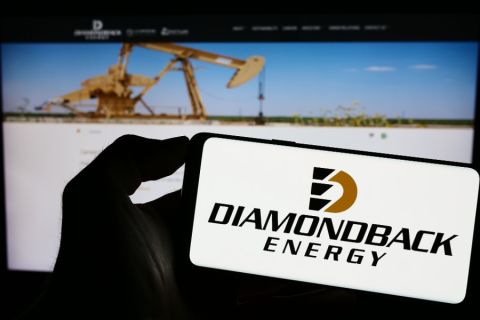
Coexistence is a necessity as energy companies of all types work to meet the world’s growing energy needs. (Source: Shutterstock)
The competition between fossil fuels and renewables, often at odds in the political arena, plays out differently in the real world.
When oil operators and solar energy companies target the same piece of property to develop energy resources, the landowner holds the key to unlocking cooperation between the two, according to experts specializing in land and exploration.
That common ground was the topic of discussion when attorneys and multigenerational landowners gathered for a recent panel at NAPE’s Renewable Energy Hub. Coexistence is a necessity as energy companies of all types work to meet the world’s growing energy needs with an all-of-the-above approach focused on lowering emissions.
In Texas, the nation’s top oil and wind producer, more than 95% of the land is privately owned. Industry group American Association of Professional Landmen has made available a shared-use agreement to tackle surface issues that may arise. Making space for each other looks different depending on the project, location and the project’s stage of development.
“If there’s an active lease, then they’re going to know their drill plan and they move a lot faster than us in some cases,” Raina Hornaday, general manager & co-founder at Caprock Renewables LLC, said noting it’s better not to be in the construction phase at the same time.
She added the two can also team up on cost-sharing such as for payments associated with roadways. Plus, relationships formed via shared use agreements can provide an opportunity for oil and gas companies to get involved in renewables, such as powering operations with solar energy.
For instances in which there is not an active lease, petroleum engineers can analyze the potential for an operator to eventually come in, Hornaday added.
Having those geological-related conversations should happen during early negotiations, added Braun & Gresham attorney Laura Bowen, a fifth-generation cattle rancher whose family leased to solar and wind developers.
“We want to get everybody to the table and talk about ‘What is it that you need?’ They’re all developers. How can we make space for you? And of course, that looks different for every project,” Bowen said. “If we are in, say, West Texas. I have a couple agreements right now. We’re looking at three large laterals. How much space do we need for these super pad sites? That looks very different than maybe North Texas where you’ve got shallow verticals and we need to overlie our drilling set aside right over that productive formation.”
Plus, new oil drilling or solar technologies may emerge, or other forms of energy development such as geothermal could accelerate, adding complexity — and more potential suitors — to mineral and surface rights owners.
Navigating the early stages of agreements also involves mineral accommodation, Bowen said. Surface waivers, where a mineral estate owner waives the right to use the surface of land where a project is located, was prevalent five years ago. Now, with more negotiations underway, “we started to move into the mineral accommodation space.”
Accommodation, in essence, requires owners of mineral and surface rights to accommodate each other’s property uses.
“We’re talking about how far are we setting back our surface facilities from your drilling facilities? How are we using roads? How are we sharing potentially in utilities? That’s the mineral accommodations side,” Bowen said. “So rather than [saying] you can’t use the surface full stop. It’s how can we work together.”
Bowen was among the attorneys involved in creating the joint lease agreement.
“The feedback that we got from the industry is, yes, you can take a form like this,” Bowen said, “because we, as the solar company, have our space and then you, as mineral owner, have some relative assurance that you can continue to operate on this project, and we can be there together.”
Though lease entanglements aren’t unique to solar, Texas has seen more activity in this area as the fast-growing sector moves into spaces that are traditionally areas for oil and gas production.
Clifton Squibb, an oil, gas and mineral lawyer and partner with Munsch Hardt Kopf & Harr, said he has many clients who are either working to cooperate with renewable developments or considering it.
“There are plenty of reasons why oil and gas operators will have an incentive to cooperate with solar and other kinds of renewable development,” said Squibb.
“What I would say from the operator perspective is you never know when you’re going to need something from somebody,” he said, pointing out there are surface owners who want to monetize their assets and see solar developments proceed.
On the other side, an oil and gas operator drilling a smaller allocation may want to put a pad site or saltwater disposal well on a property.
“To do that, you need cooperation with the landowner. So sometimes I feel like the landowner is the key … to unlock cooperation between oil and gas operators and solar developers,” Squibb said.
Being motivated to find common ground helped Texas rise to become the No. 1 producer of oil and gas, wind and soon-to-be solar, according to Melissa Miller, co-chair of CleanTX and senior vice president of Development for Eolian Energy. Her experience includes serving as a landman, knocking on doors for wind projects.
“How did we get here if we didn’t make that an active choice? If landowners didn't make that an active choice, if our industry didn't make that an active choice,” she said. “We got here because we are an energy leader.”
Recommended Reading
TotalEnergies Eyes Suriname FID by Year-end 2024
2024-04-29 - France’s TotalEnergies and U.S. partner APA Corp. look to place their long lead orders ahead of a final investment decision related to their joint development offshore Suriname in Block 58.
Diamondback Stockholders All in for $26B Endeavor Deal
2024-04-29 - Diamondback Energy shareholders have approved the $26 billion merger with Endeavor Energy Resources.
ProPetro to Provide eFrac Services to Exxon’s Permian Operations
2024-04-29 - ProPetro has entered a three-year agreement to provide electric hydraulic fracturing services for Exxon Mobil’s operations in the Permian Basin.
Keeping it Simple: Antero Stays on Profitable Course in 1Q
2024-04-28 - Bucking trend, Antero Resources posted a slight increase in natural gas production as other companies curtailed production.
Oil and Gas Chain Reaction: E&P M&A Begets OFS Consolidation
2024-04-26 - Record-breaking E&P consolidation is rippling into oilfield services, with much more M&A on the way.






